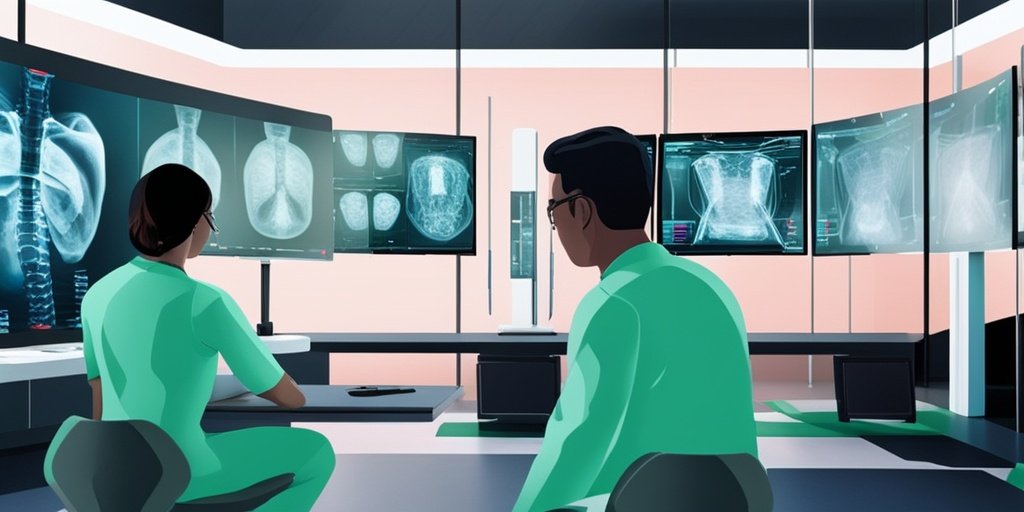⚡ Quick Summary
A recent study evaluated the performance of the qXR v2.1 deep learning algorithm for classifying chest X-rays (CXRs) as normal or abnormal in visa screening centers across the United Arab Emirates. The algorithm demonstrated a remarkable Negative Predictive Value (NPV) of 99.92%, indicating its potential to significantly enhance the efficiency of radiological assessments.
🔍 Key Details
- 📊 Dataset: 1,309,443 CXRs from 1,309,431 patients
- 🧩 Features used: Chest X-ray images
- ⚙️ Technology: qXR v2.1 deep learning algorithm
- 🏆 Performance: NPV 99.92%, PPV 5.06%, overall agreement with radiologists 72.90%
🔑 Key Takeaways
- 📊 High volume of data analyzed, showcasing the algorithm’s robustness.
- 💡 AI integration significantly reduced turnaround times for radiologists.
- 👩🔬 Majority of radiologists (82%) reported improved diagnostic accuracy with AI assistance.
- 🏥 AI can reliably identify normal CXRs, allowing radiologists to focus on abnormalities.
- 🌍 Study conducted across 33 visa screening centers in the UAE.
- 🗓️ Study duration: January 2021 to June 2022 (18 months).
- 🤖 AI’s role in healthcare is becoming increasingly vital, especially in high-volume settings.

📚 Background
Chest radiographs (CXRs) are essential tools for screening infectious diseases, particularly in high-volume settings such as visa screening centers. However, the manual reporting of CXRs can be labor-intensive and prone to human error. The integration of artificial intelligence (AI) into the workflow can streamline this process, enabling faster identification of normal findings and allowing radiologists to concentrate on more complex cases.
🗒️ Study
This post-deployment study involved the analysis of CXRs collected during the visa screening process across 33 centers in the United Arab Emirates over an 18-month period. The qXR v2.1 software was employed to classify the scans, and its performance was compared against that of human radiologists. Additionally, a digital survey was conducted among 20 healthcare professionals to gather insights on the real-world implementation of AI in radiology.
📈 Results
The study revealed a Negative Predictive Value (NPV) of 99.92% and a Positive Predictive Value (PPV) of 5.06%. The overall agreement between the AI and radiologists was found to be 72.90%. These findings suggest that the AI can effectively identify normal CXRs, which is crucial for enhancing the efficiency of radiological assessments in busy healthcare environments.
🌍 Impact and Implications
The results of this study have significant implications for the future of radiology. By demonstrating the ability of AI to accurately classify CXRs, this research supports the notion that AI can play a vital role in routine clinical practice. The integration of such technologies could lead to improved patient outcomes, reduced workloads for radiologists, and more efficient healthcare delivery systems.
🔮 Conclusion
This study highlights the transformative potential of AI in radiology, particularly in high-volume settings like visa screening centers. With a high NPV and satisfactory agreement with human readers, the qXR v2.1 algorithm shows promise for routine applications in healthcare. Continued research and development in this area could pave the way for broader adoption of AI technologies in medical diagnostics.
💬 Your comments
What are your thoughts on the integration of AI in radiology? Do you believe it can significantly improve diagnostic processes? 💬 Share your insights in the comments below or connect with us on social media:
Post-deployment performance of a deep learning algorithm for normal and abnormal chest X-ray classification: A study at visa screening centers in the United Arab Emirates.
Abstract
BACKGROUND: Chest radiographs (CXRs) are widely used to screen for infectious diseases like tuberculosis and COVID-19 among migrants. At such high-volume settings, manual CXR reporting is challenging and integrating artificial intelligence (AI) algorithms into the workflow help to rule out normal findings in minutes, allowing radiologists to focus on abnormal cases.
METHODS: In this post-deployment study, all the CXRs acquired during the visa screening process across 33 centers in United Arab Emirates from January 2021 to June 2022 (18 months) were included. The qXR v2.1 chest X-ray interpretation software was used to classify the scans into normal and abnormal, and its agreement against radiologist was evaluated. Additionally, a digital survey was conducted among 20 healthcare professionals with prior AI experience to understand real-world implementation challenges and impact.
RESULTS: The analysis of 1309,443 CXRs from 1309,431 patients (median age: 35 years; IQR [29-42]; 1030,071 males [78.7 %]) in this study revealed a Negative Predictive Value (NPV) of 99.92 % (95 % CI: 99.92, 99.93), Positive Predictive Value (PPV) of 5.06 % (95 % CI: 4.99, 5.13) and overall percent agreement of the AI with radiologists of 72.90 % (95 % CI: 72.82, 72.98). In the survey, majority (88.2 %) of the radiologists agreed to turnaround time reduction after AI integration, while 82 % suggested that the AI improved their diagnostic accuracy.
DISCUSSION: In contrast with the existing studies, this research uses a substantially large data. A high NPV and satisfactory agreement with human readers indicate that AI can reliably identify normal CXRs, making it suitable for routine applications.
Author: [‘AlJasmi AAM’, ‘Ghonim H’, ‘Fahmy ME’, ‘Nair A’, ‘Kumar S’, ‘Robert D’, ‘Mohamed AA’, ‘Abdou H’, ‘Srivastava A’, ‘Reddy B’]
Journal: Eur J Radiol Open
Citation: AlJasmi AAM, et al. Post-deployment performance of a deep learning algorithm for normal and abnormal chest X-ray classification: A study at visa screening centers in the United Arab Emirates. Post-deployment performance of a deep learning algorithm for normal and abnormal chest X-ray classification: A study at visa screening centers in the United Arab Emirates. 2024; 13:100606. doi: 10.1016/j.ejro.2024.100606